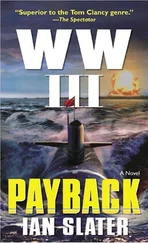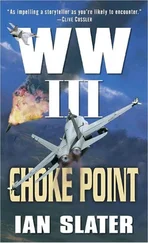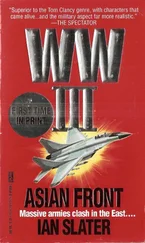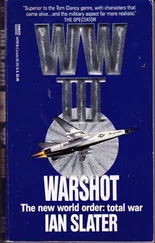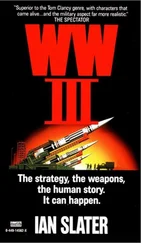“There’s no muck to throw around,” she’d challenged him bravely. She remembered his sneering, cold reply. “You’re so fucking naive, Lana, I don’t believe it. Doesn’t matter whether it’s true or not. Once it hits the street on page one, it’s game over for the Brentwoods, sweetheart.”
It was little wonder, Shirer realized as they had parted in Dutch Harbor, that she’d learned to roll with life’s punches— their Washington-enforced separation not upsetting her as much as he had expected, or secretly hoped, it might. And yet he knew she loved him. Still, her greatest fear wasn’t of separation but of him simply vanishing somewhere over the vastness of the Pacific, more terrifying to her than anything Jay La Roche might have done.
“I won’t get shot down, honey,” he’d tried to assure her, recognizing the hollowness of it as soon as he spoke.
“You have been already.”
“Then it’s over. Finished. One time is all you’re allowed. If you get out of that — you’re home and—”
A luminescent green dot, the size of a pinhead, was blipping on his radar screen. The carrier.
He had done it hundreds of times before, but during the approach, his stomach still knotted, his G suit warmer as the perspiration increased, his heartbeat, like most pilots’, faster now than when in a dogfight. He still couldn’t see the ship through the gray candy floss cloud flitting below him like a black river. With air brakes full on, he was coming in at over 150 miles an hour. He remembered that during Freeman’s raid on Pyongyang, Salt Lake City had lost more planes on landing than in combat — the slightest thing going wrong could mean curtains. But it hadn’t happened to him yet and — hell, he told himself cavalierly, it wasn’t going to happen now, even if Salt Lake City’s air boss was always claiming a fighter pilot’s worst enemy wasn’t the Russians but a woman who took your mind off “one joystick onto another.”
No way, Shirer told himself, feeling the slight vibration of his oxygen mask, convinced that the thought of making sweet, unhurried love with Lana was the best guarantee in the world that he wouldn’t foul up. His vector was dead on — five minutes to the carrier, the possibility of enemy fighters suddenly appearing and pouncing remoter than ever.
* * *
In Salt Lake City’s air traffic control with the CIC — combat information center — and in PRIFLY — primary flight control, above flight deck control — computers and status boards showed Tomcat 203 approaching the carrier with fifty-seven thousand pounds gross weight — information conveyed instantaneously to the LSO — landing signal officer — in the flight deck’s trench. The LSO, his Day-Glo orange vest only dimly visible above the deck’s skirting, kept one eye on the video recording 203’s approach, and the SPIN, or speed indicator, that showed the Tomcat’s approach speed. This speed, together with that of the crosswind and carrier, aided the LSO in deciding the correct tension for the four arrestor wires. Too little would fail to stop the fighter within the three hundred feet — too much could snap the cable, with the same result.
“Tomcat two zero three, five seven zero,” came the confirmation from the arresting gear room, whose crew of four set the dials for fifty-seven-thousand pounds. Shirer was looking for the orange ball of light in the big convex mirror mounted on the carrier’s starboard side. If centered, the orange blob of light would be a second visual confirmation of the glide path projected by his computer. There were so many variables: state of sea, humidity, cloud cover, wind sheer…
He saw the orange ball between two horizontal green lights, but it was above the mirror’s midline. He was too high. Quickly he realigned degrees of flap, saw the orange orb go dead center, and called, “Meatball,” which told the LSO he was “on the ball”—locked into the correct glide path, the relief in his voice palpable despite his long experience.
The LSO’s voice blasted Shirer’s earpiece and suddenly, either side of the meatball, he saw two vertical red lines appear. A wave off. “Damn!”
“Try again,” instructed the LSO, Shirer hitting the button for full afterburner, the Tomcat veering hard left, engines screaming in a banshee howl as it climbed, leaving the carrier’s island leaning hard right and slipping downhill. Then the carrier was gone, below cloud.
“Try again two oh three,” repeated the LSO. “Nose wheel not lowered.”
In flight deck control, a man on the “Ouija” board moved the plastic model of 203 to the side while another crewman took up his grease pencil, a backup in case of power failure, and marked 203’s position on the transparent plastic screen, asking, “He a nugget?”
“No,” replied Comdr. Phil Harris, the officer in charge of FDC — flight deck control—”nothing green about him. Been on this tub longer than you have.”
“Two oh three?” said the crewman disbelievingly. “I haven’t heard of a Tomcat of ours with that number.”
“It’s been in Dutch Harbor. Watch him — he’s turning.”
“Got him,” replied the seaman cockily, skidding the plastic model around. Two oh three was already on infrared video, its ghostly outline like an underdeveloped negative, a heat blur around the twin twenty-one-thousand pound Pratt and Whitney exhausts, heat streamers trailing from the fuselage’s shimmering edge.
Shirer pressed the nose wheel release button again, unable to hear whether or not it was coming out of its well because of the noise of the fighter’s engines, the indicator nevertheless showing the wheel was down, his G suit feeling like a sauna as he took another run over the carrier, alert for other incoming aircraft. He was on a vector that would take him fifty feet above the flight deck, giving the LSO and other deck crew plus everyone in PRIFLY a chance to see whether the wheel was in fact down.
“There it is!” said one of the red-jacketed ordnance crew.
“No,” responded a green jacket from electronics maintenance, his arm following the line of the plane, “it’s only half-extended.”
“You sure?”
“Sure I’m sure.”
The LSO saw it swooping directly overhead through the mist. “LSO to two oh three. Your nose wheel is only half-extended. Do you read me?”
“Affirmative. Nose wheel half-extended,” came Shirer’s voice, crackling through static.
“LSO to two oh three. Go to five thousand. Repeat, five thousand. Minimum radius ten miles. Repeat ten miles and hold pattern. I say again, hold pattern.”
“Going to five thousand,” confirmed Shirer, silently cursing the nose wheel. “Will hold pattern.” The carrier couldn’t waste any more time on him at the moment. He would have to hold pattern until Salt Lake City got all its other planes, which included combat patrols approaching “Bingo”—fuel exhausted — status, and only then, when his Tomcat’s fuel was all but gone, reducing the risk of fire, could they try to bring him in.
His eyes refocused on his helmet display, which remained steady, despite the motion of the fighter. Shirer could see he had fifty-seven minutes of fuel remaining. Meantime he’d try the wheel again. He thought he felt it give a little — hoped that it might only be a bird jamming the lower gear. A bird’s body, most likely a gull, would compress on retraction — unless it was one of the big wandering albatross with a wingspan up to seven feet, but he’d felt no impact.
He tried the release again and it seemed to give, but only a fraction. Trouble was, it was so damn hard to be certain, given all the noise. Simultaneously the indicator panel’s constant flickering demanded close attention if he was to avoid midair collision.
Читать дальше


